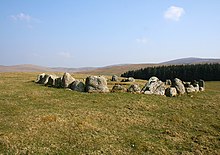Ring Cairn
A Ring Cairn (sometimes also correctly called "Ring Bank Enclosure", incorrectly referred to as Ring Barrow) is a slightly oval or round, ring-shaped, low (maximum 0.5 m high) but sometimes several meters wide wall structure, from 8 to 22 m in diameter, made of rubble and earth, which was originally empty in the middle. In some cases the center was used later (in Manaton, at the Hound Tor with a stone box - Cornish: Kistvaen). The low structure of the Cairns cannot always be seen without excavations.
description
The Bronze Age plants are between Cornwall ; Wales and Derbyshire ( Barbrook IV and V and Green Low) are common in England, Scotland and Ireland and are also built as a curb cairn as a very small ring of large curbs, the center of which has been filled. The main concentration is in Mid Wales, but also in the Clava Cairns area .
The Cairns (also known as Platform Cairns) look like flat editions of the several times higher Clava Cairns , which laymen also refer to as the Ring Cairns. Although burials have been found in some of the rings, this does not seem to have been their original purpose. In the central area graves and pits with corpses, fire pits and sometimes small low cairns ( green low ) are found.
Ring Cairns may have had a function somewhere between that of the much older henges and that of the stone circles of the same time . The fact that there are so few stone circles in south-east Wales may be due to the fact that Ring Cairns ( Ring Cairns of Brenig ) were built there instead .
The slightly oval Ring Cairns near Arthur's Stone on the Gower Peninsula show that the inner edge of Ring Cairns was built with particular care and a small moat was in front. Originally there was a passage through the ring that was around ten meters wide inside, which was blocked when it was no longer used.
Cairns platform
Platform cairns, such as the Brenig and Carn Ferched , are a subspecies of the Ring Cairns. They are flat, round stone platforms, which are sometimes framed on the outside by carefully crafted, level curbs up to 0.5 m high. Inside, they are structured differently and often contain stone boxes or small cairns. It is often difficult to determine this type of cairns without excavation, as the initially flat shape can turn out to be a cairn from which most of the stones were later removed.
At the recently excavated Gray Hill Cairn, in Monmouthshire in South East Wales , where platform cairns are common, the carefully crafted surface within the curbs shows that it was built as a platform.
See also
literature
- Frances Lynch: Ring cairns and related monuments in Wales. In: Scottish Archaeological Forum. 4, 1972, pp. 61-80
- Frances Lynch: Ring cairns in Britain and Ireland: their design and purpose. In: Ulster Journal of Archeology. 42, 1979, pp. 1-19
Web links
- "Carnau Cefn-y-Ffordd", Ring Cairns Short text and pictures
- Aerial view from the Hound Tor Ring Cairn
- Manaton Cairn picture
Individual evidence
- ↑ The difference between a stone circle and a ring cairn is that the ring cairn was built to encircle a stone box that was covered by a (usually no longer existing) cairn, while the stone circle in its original state did not have these fixtures having.
- ↑ The situation is rather different on the gritstones of the eastern uplands. Here it is more common to find smaller stone circles and ring cairns. The patterned relationship of these smaller monuments to cairnfield systems throughout the eastern moors suggests that they were built and used by specific communities, probably in the centuries around 2000BC. Although details vary from one site to another, nearly all comprise a ring of small upright stones set on the inner edge of a roughly circular bank.



